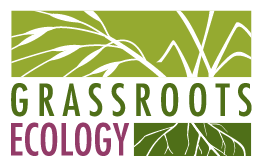A Win for Local Water Quality
Down by the creek below Westwind Barn in Los Altos Hills, habitat is flourishing again.
In just three years, our staff and volunteers have transformed a creekside area below Westwind’s horse paddocks and stables into a thriving mosaic of native vegetation. Not only does this vegetation provide food and shelter for wildlife, it also helps to slow, sink, and filter stormwater before it washes into the creek—contributing to a cleaner, healthier watershed.
Before we began the project, the area was weedy, barren, or muddy, depending on the season. Paddocks that had been built up along the creek stood abandoned due to flooding from storm events that rendered them unusable for horses.
But even with the lower horse paddocks now vacant, the area was problematic for water quality. Runoff from storm events would wash through the active horse areas down the steep hillside and into the creek, carrying pollutants with it and eroding the soil. In the dry season, the area teemed with invasive weeds—from stinkwort to poison hemlock to thistles galore—displacing the native species that had once grown there.
Three years, two berms, and 684 volunteers later, the landscape looks—and acts—very different. Here’s how we got there:
Fall 2018
We marked the contour of the land and the pathway of water as it flows down toward the creek. Then we dug a trench along those contour lines to create our first berm.
We filled the trench with woody debris to catch and divert polluted water flowing down the hillside.
Winter 2019
We mulched and installed locally native plants in and around the berm, selecting species such as California rose, bee plant, and yerba buena that filter out pollutants and also support local wildlife.
Spring 2021
We installed a second berm along the contour of the land. This time we vegetated with willow stakes and bundles, using cuttings we gathered from native willow trees growing on site. Willows self-propagate and are excellent at slowing and catching sediment and pollutants.
Each summer, we removed invasive weeds and suppressed their spread by sheet mulching with cardboard and wood chips.
The vegetated berms we created now capture and infiltrate stormwater runoff, protecting the surrounding creek, the soil, and the wildlife within. Nearly 2,000 plants grown at our Native Plant Nursery from 35 distinct native species and hundreds of willow cuttings offer forage and shelter for the wildlife that utilizes this riparian corridor.
Special thanks to our devoted Youth Stewards, Interns, and these volunteer groups for all the time and effort they contributed:
National Charity League
Jenna Swaim Restoration Foundation
St. Simon Parish School
Nueva School
Woodside Priory School
Averroes High School
Sacred Heart Preparatory School
Dream Volunteers
And finally, thanks to Valley Water, the Town of Los Altos Hills, and Westwind Community Barn, whose support and partnership made this project possible.
By Valerie Lee, Community Engagement Manager








